I see a lot of questions about boar bristle brushes in forums discussing no-poo lifestyles. For those who don’t know, no-poo means that a person washes their hair using homemade or herbal products, rather than commercial soaps or shampoos. Some people use only water, with mechanical methods of moving the oils on their hair. The idea is that the scalp will come to better regulate its own sebum production if one stops stripping their hair and scalp of its natural oils by using harsh shampoos. Although the movement is picking up with a number of different groups, people with ACD, or allergic contact dermatitis, seem to be changing over in higher numbers than others. While for some it can be a lifestyle choice, for the allergic going no-poo can often be a necessity. While the promise of no-poo is that your hair will need a full wash less and less often, with rinses in between, there is an increased amount of maintenance required. The boar bristle brush is one of these things.
What does brushing with a boar bristle brush or equivalent do for me?
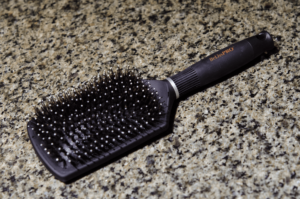 While no-poo is a more natural method of cleaning the hair, it doesn’t mean you need to walk around with stringy hair or dreadlocks. Brushing your hair is an important step in your hair care routine, even more so than for people who use shampoo. Using a brush or comb that has tight, grippy bristles helps to move the sebum down the length of your hair, providing your hair natural moisture and shine. It also helps to clear out dust and debris from your hair and scalp, preventing scalp oil and debris buildup. The old adages to “brush hair for 100 strokes per day” and such are believed to be because people in the past washed their hair less often and didn’t use commercial shampoos, just like the no-poo movement today, and the 100 strokes were to move the sebum down the hair shaft each day.
While no-poo is a more natural method of cleaning the hair, it doesn’t mean you need to walk around with stringy hair or dreadlocks. Brushing your hair is an important step in your hair care routine, even more so than for people who use shampoo. Using a brush or comb that has tight, grippy bristles helps to move the sebum down the length of your hair, providing your hair natural moisture and shine. It also helps to clear out dust and debris from your hair and scalp, preventing scalp oil and debris buildup. The old adages to “brush hair for 100 strokes per day” and such are believed to be because people in the past washed their hair less often and didn’t use commercial shampoos, just like the no-poo movement today, and the 100 strokes were to move the sebum down the hair shaft each day.
What are my options for brushes and combs?
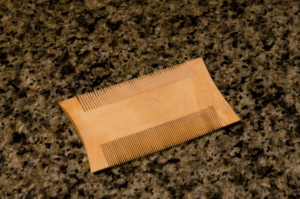 The most common tool is a boar bristle brush, which is available from most beauty supply stores. These brushes come in a variety of stiffnesses, so you can choose one that is right for you. Some people are uncomfortable with these brushes or object to them for ethical reasons (boar bristles come from boars), so they instead use bamboo-bristled brushes. Still another tool is a fine-toothed comb. Some people use nit combs such as you might pick up from a drug store, while others just use a wooden comb. I use a boar bristle hybrid brush and a medieval-style wooden comb.
The most common tool is a boar bristle brush, which is available from most beauty supply stores. These brushes come in a variety of stiffnesses, so you can choose one that is right for you. Some people are uncomfortable with these brushes or object to them for ethical reasons (boar bristles come from boars), so they instead use bamboo-bristled brushes. Still another tool is a fine-toothed comb. Some people use nit combs such as you might pick up from a drug store, while others just use a wooden comb. I use a boar bristle hybrid brush and a medieval-style wooden comb.
How often do I need to do this?
Some people use these tools and methods every day, but too much scalp stimulation can encourage more sebum production. I tend to use the brush or comb the day after my wash, and then every 2 to 3 days after that.
How do I use a boar bristle brush or equivalent?
Here is how I do it:
- Start by making sure your brush or comb is clean (see below). A dirty brush will spread sebum, dust, and dead skin back onto your hair and scalp – not what we’re going for here.

- Part your hair horizontally across the back of your head, about 2 to 3 inches from the nape of your neck. if your hair is very thick or curly, start lower.
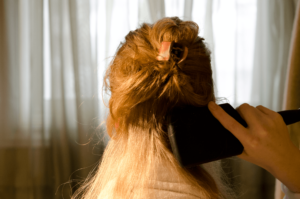
- Hold or clip the top hair up, then use the comb or brush of your choice to brush the bottom part of hair and your scalp.
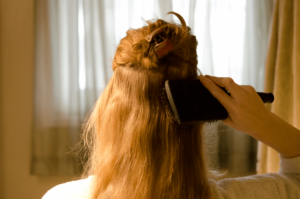
- Let your hair down and part it again horizontally across the back of your head, this time 2 to 3 inches higher than the last time. If you hair is very thick or curly, go only 1 to 2 inches up from the last part.
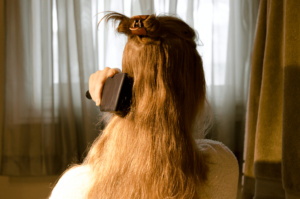
- Brush or comb both bottom layers of hair combined.
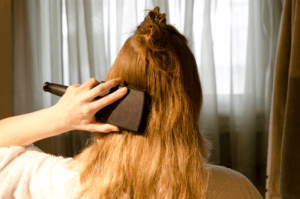
- Repeat, moving 1 to 3 inches higher on the head for each part, until you have combed or brushed your entire head and scalp. I like to follow up with a short brushing with a regular brush to loosen up the hair and style it.
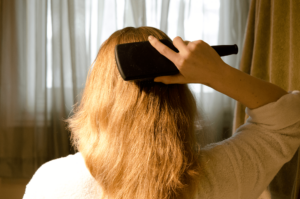
How do I care for my brush or comb?
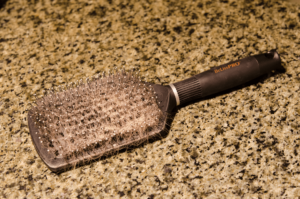 Because you are removing sebum, dust, and dry skin from your hair, this material has to go somewhere. That usually means into your brush or comb. Luckily, there are a number of ways to clean these important tools:
Because you are removing sebum, dust, and dry skin from your hair, this material has to go somewhere. That usually means into your brush or comb. Luckily, there are a number of ways to clean these important tools:
- Brush off surface debris with an old toothbrush. Do this with the brush and toothbrush dry, so that the debris can easily fall off. This will not make a brush really clean, but it’s a good cleaning method in a pinch.
- Wash the brush with the shampoo you’re not using on your head. It’s already designed to remove the things you’re removing from your hair, so it’s formulated right, provided you’re not allergic to the ingredients. Use an old toothbrush to provide friction between the bristles and on the cushion. Be careful about using soaps, as the high alkalinity can harm boar bristles, making them more porous, and hard water can cause soap scum buildup.
- Use what you’re using on your hair to clean the brush. This is not the same as using shampoo, above, because the cleaning methods you use will not remove all of the sebum from the brush, just as they don’t remove all sebum from your scalp.
- Soak the brush in about 4/5 water and 1/5 peroxide for several hours. Over time, the peroxide will dissolve or loosen most of the contaminants, at which point you can clean the remainder of these contaminants off of the brush with a toothbrush and water. This method can harm brushes if used too often or if the liquid is allowed to settle in the cushion of the brush (if applicable). To avoid this, I will set the brush horizontally so that only the bristles are in the water, not the cushion or base of the brush.
- Do not leave brushes or combs made with any volume of wood sitting in water. The water will swell the wood and when it dries it is likely to crack. Even boar bristles left for too long in water can start to lose the glue that holds them into the brush.
Do you have any other questions about using brushes and combs to maintain no-poo hair? Comment below.
